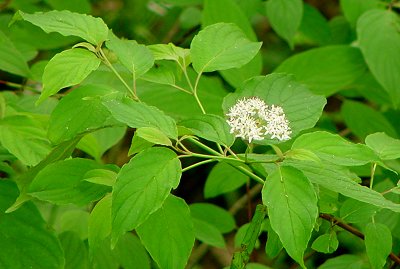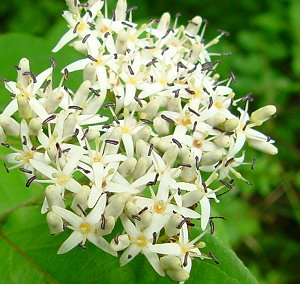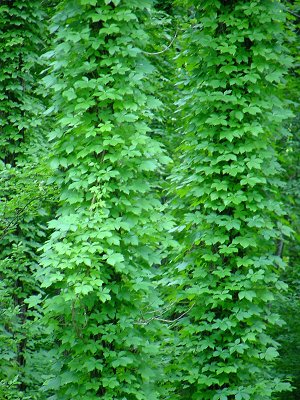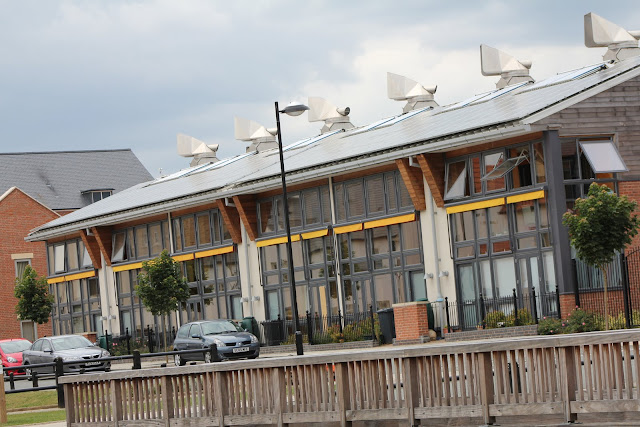
(Photo: Maryana starting the crux section of Commando Rave (5.9).)
Last Sunday was a gorgeous day, with highs in the mid- to-upper sixties. In other words: sending weather. High season, baby!
I was meeting up with Maryana for the first time in a while. She had been forced to take an eight-week break from climbing because of a cycling accident in the city, which had left her with several fractures in her back. This was a heartbreaking blow for her, coming as it did right in the middle of a great climbing year. Before the accident Maryana had led some truly impressive Gunks 5.10's (like Birdcage, for example). But now she had to rebuild. I was climbing with her on only her second weekend back in the climbing game.
We started with a nice warm-up. I led both pitches of Son of Bitchy Virgin (5.6) in one, running it all the way to the GT ledge. I'd never done the first pitch before. It is okay, but after the initial 5.5 overhang there isn't really much to recommend it. I think the second pitch is quite nice, but it is better approached via the Immaculate Conception variation.
After our warm-up Maryana did an excellent job leading Dry Heaves, a challenging 5.8. Then I got down to business with one of those 5.9's I still hadn't gotten around to: Commando Rave.
Dick Williams suggests in his guide book that Commando Rave is a polarizing climb. He says some love it and some hate it. I guess the hate springs from the lack of pro before the crux. The climb begins with some nice moves up a seam. Then comes an unprotected thirty-foot (!) traverse, but really this traverse is so easy it is barely fifth class. For most of it you are basically walking on a sidewalk. And about two-thirds of the way across I actually got a big blue Camalot in the crack at my feet. After that the rest of the way was well-protected.
The crux is really fun. You angle up and right through some overhangs to a left-facing corner. The hardest bit comes as you reach the end of the roof at the corner. You have to hang in to place a bomber piece, and then it takes a balance move out right to escape the corner and reach up to the good hold.
Once through the crux the belay tree is just a couple of moves away. Commando Rave is good, featuring a solid 5.9 crux. It is a quality quick tick, and totally worth doing. It isn't amazing, and it certainly isn't bad. I really can't imagine loving or hating it.

(Photo: Heading up to the big roof on Dat-Mantel (5.10b).)
I felt pretty good about Commando Rave, and afterwards thought I might get another quick tick, this time of a 5.10. I jumped right on the nearby Dat-Mantel.
This was a climb I'd aborted leading with Gail. On that occasion I was just getting up to the roof when I realized I needed some big gear I'd already used below, and then it started raining. After abandoning the lead I sent it pretty easily on toprope on the first try. Pissed to have found it so easy, I resolved then to try to come back and get the redpoint on lead before was out.

(Photo: Getting ready to attack the roof on Dat-Mantel.)
This time, on lead, I wouldn't say it went easily, exactly. I fumbled about a bit before figuring out how to reach the bomber horizontal above the roof. Then I was psyched to place two good cams above the roof, one for each of our double ropes.
I got set to throw a heel and pivot over the roof....
And it worked out. It took a few tries. It wasn't pretty. I remember standing right up over the roof when I did it on top rope. On lead, by contrast, I ended up basically pushing my whole leg and hip into the rock before I could pull myself over the roof. But I never weighted the rope, and I made it! I'll gladly call it a victory and put it in the bank.
Dat-Mantel is a good introductory 5.10. The crux is short and the pro is great. You should be careful as you figure out how to reach the horizontal over the roof. There is good pro at the back, where the roof meets the wall, but until you can plug that horizontal over your head a fall will send you down onto the slab.It wouldn't bea dangerous fall, but it would be unpleasant. Once you get your fingers in the horizontal, however,there are great placements left and right, and you can try the roof move over and over again without falling onto the rope.
After Dat-Mantel my day was as good as done. With a new 5.9 onsight to my credit plus a successful 5.10, I was content to coast. Maryana proved herself to be the comeback kid, leading two more hard 5.8's: the wonderful first pitches of both Carbs & Caffeine and Airy Aria. I then got to end our day by combining the beautiful second and third pitches of Airy Aria into one lead, a fitting finish to a glorious day of climbing.
I love sending season.
 While we were having fun on the boat, we came across this place that we just so happened to hit the tide right so we could get out and explore by land some. This had the kids very excited! The boys hopped out and pulled us as close to shore as possible. Austin carried Lauren so she didn't have to deal with water creatures.
While we were having fun on the boat, we came across this place that we just so happened to hit the tide right so we could get out and explore by land some. This had the kids very excited! The boys hopped out and pulled us as close to shore as possible. Austin carried Lauren so she didn't have to deal with water creatures. After walking across some very, very slimy water and dodging jelly fish, we hit the land. Once we hit land, we were all super excited about this venture.
After walking across some very, very slimy water and dodging jelly fish, we hit the land. Once we hit land, we were all super excited about this venture.
 The kids rushed ahead to see what exactly was here. They liked the bird blind. Josh filled us in on what he thought this place was all about. Josh knows everything about everything, so we learned a lot!
The kids rushed ahead to see what exactly was here. They liked the bird blind. Josh filled us in on what he thought this place was all about. Josh knows everything about everything, so we learned a lot! We all liked the nature we found there. Can't you just smell the sand and sea salt?
We all liked the nature we found there. Can't you just smell the sand and sea salt? Sometimes we approach learning differently in our households. Sometimes it looks very similar. Today was an example of where we approach learning in the same way. In both our homes, it is a daily thing where learning looks just like what you see here. Someone finds something interesting and eventually you find the whole gang gathered around discussing it.
Sometimes we approach learning differently in our households. Sometimes it looks very similar. Today was an example of where we approach learning in the same way. In both our homes, it is a daily thing where learning looks just like what you see here. Someone finds something interesting and eventually you find the whole gang gathered around discussing it. Well, except for Josh...who has his own path to explore at the moment!
Well, except for Josh...who has his own path to explore at the moment! I love how we will all roll up into the learning and enjoy it together, each adding something to the experience. It's one of the things I most enjoy about traveling with Daryl and Diana. So what kinds of goodies did we find?
I love how we will all roll up into the learning and enjoy it together, each adding something to the experience. It's one of the things I most enjoy about traveling with Daryl and Diana. So what kinds of goodies did we find? Pretty cool, huh? Diana graciously took a picture of us, and right after that my battery died so I did not get one of them.
Pretty cool, huh? Diana graciously took a picture of us, and right after that my battery died so I did not get one of them. This place ended up being so awesome, I'm putting it down as one of my faves. It's been a long time since I did that, so I guess we were due one! Thanks, Daryl and Diana for making our day so great.
This place ended up being so awesome, I'm putting it down as one of my faves. It's been a long time since I did that, so I guess we were due one! Thanks, Daryl and Diana for making our day so great.
 Hazlette Wise, Grace Zinsmeister, and Ethel Wise.
Hazlette Wise, Grace Zinsmeister, and Ethel Wise.




 Photographs taken on April 8, ...
Photographs taken on April 8, ...





 I'm not embarrassed in the least that we were so geeky excited over it, because it is cool. Really, really cool to be this close to elk. We're asking Elijah what he thinks and making a big deal about it. He's not real impressed. Then we realize that he can't see from way down there. He was a little more excited when I put him on my shoulders.
I'm not embarrassed in the least that we were so geeky excited over it, because it is cool. Really, really cool to be this close to elk. We're asking Elijah what he thinks and making a big deal about it. He's not real impressed. Then we realize that he can't see from way down there. He was a little more excited when I put him on my shoulders. Then Ashleigh and I noticed that way on the other end of this place there appeared to be a group of people doing something with a group of animals. We say that maybe the elk are closer to the fence down there and people are getting to feed them or something. Because Nathan can be a know it all, he says nah...those are deer. We squint and look again and say...uh...I don't think those are deer. If they are, those are some monster deer or something because they are big. And the guy at the office said we could feed them crackers sometimes and we can't do that from here. But we might be able to do it from there. Because I can be pushy, I say...let's go!
Then Ashleigh and I noticed that way on the other end of this place there appeared to be a group of people doing something with a group of animals. We say that maybe the elk are closer to the fence down there and people are getting to feed them or something. Because Nathan can be a know it all, he says nah...those are deer. We squint and look again and say...uh...I don't think those are deer. If they are, those are some monster deer or something because they are big. And the guy at the office said we could feed them crackers sometimes and we can't do that from here. But we might be able to do it from there. Because I can be pushy, I say...let's go! I'm so glad we did because this is what happened there.
I'm so glad we did because this is what happened there.


 In all of about 5 seconds flat Elijah transformed from boy to warrior/man-child/great and mighty hunter. Or something like that. I half expected him to start making Tim Allen noises or something. It was awesome!
In all of about 5 seconds flat Elijah transformed from boy to warrior/man-child/great and mighty hunter. Or something like that. I half expected him to start making Tim Allen noises or something. It was awesome! Nathan was trying to help him and he did the teen hand wave that means Pfffttt...I got this one. I am boy, hear me roar! Were the elk large you might ask?
Nathan was trying to help him and he did the teen hand wave that means Pfffttt...I got this one. I am boy, hear me roar! Were the elk large you might ask? Yeah, you could say that! Dude rocks is all I have to say!
Yeah, you could say that! Dude rocks is all I have to say! (Photo by Julie Labrecque)
(Photo by Julie Labrecque)










